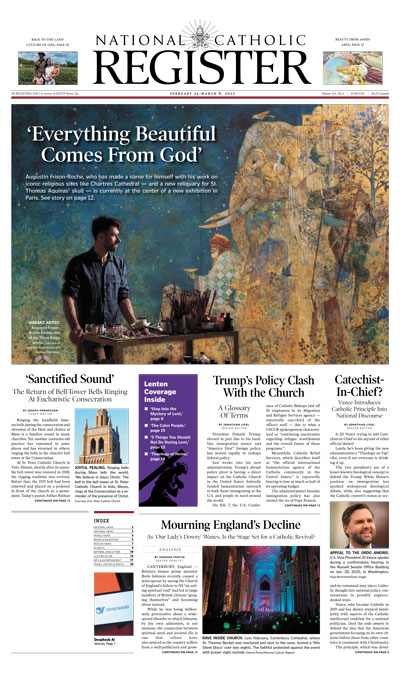St. Paulinus of Nola
Pope Benedict XVI weekly catechesis.
Weekly General Audience December 12, 2007
During his general audience on Dec. 12, Pope Benedict XVI offered his reflections on St. Paulinus of Nola as part of his series of teachings on the early Fathers of the Church. The fifth-century bishop of Nola, near Naples in Southern Italy, distinguished himself by his charity to the poor during the troubled times of the barbarian invasions. A man of letters and a gifted poet, he placed his art at the service of Christ and the Church. A master of spiritual friendship, he expressed his experience of the Church as communion especially in his vast correspondence.
Dear brothers and sisters,
Today we will focus on St. Paulinus of Nola, another Father of the Church.
A contemporary of St. Augustine with whom he shared a deep friendship, Paulinus carried out his ministry in Campania, in Nola, where he was first a monk, then a priest and later a bishop.
However, he was originally from Aquitaine in the south of France, from the city of Bordeaux, where he was born into a high-ranking family. He received a good education in literature from his teacher, the poet Ausonius. He left his country at an early age in order to follow a career in politics and he rose to the post of governor of Campania while he was still a young man.
During his public service he was admired for his gifts of wisdom and gentleness. It was during this period in his life that grace made the seed of conversion blossom in his heart. The impetus for his conversion came from the simple yet intense faith with which people honored the grave of the martyr, St. Felix, at his shrine, which is located in Cimitile.
Since he was responsible for public works, Paulinus took an interest in the shrine and built a guesthouse for the poor and a road that would make access easier for the many pilgrims.
While Paulinus was busying himself with building the earthly city, he was gradually discovering the path to the heavenly city.
His encounter with Christ was the culmination of an arduous journey full of trials. Through a series of adverse circumstances, beginning with losing favor with the political authorities, he experienced firsthand how transitory things are.
“Man without Christ is but dust and shadow,” he wrote once he came to the faith (Carme X, 289).
Out of a desire to shed light on the meaning of his life, he went to Milan to enroll in Ambrose’s school. Afterwards, he completed his Christian formation in his native land, where he was baptized by Bishop Delphinus of Bordeaux.
Marriage also played a role in his journey to the faith. He married Therasia, a devout noblewoman from Barcelona, with whom he had a son. He would have continued his life as a good Christian layman, but he was shaken by the death of his child, who was only a few days old, an event that showed him that God had a different plan for his life.
He felt called to devote himself to Christ following a lifestyle of rigorous asceticism.
Spiritual Journey
With the full agreement of his wife, Therasia, Paulinus sold his belongings in order to help the poor and, together with her, left Aquitaine for Nola. There the couple took up residence near the basilica of Nola’s patron saint, St. Felix, and, from then on, lived chastely as brother and sister following a way of life that others soon joined.
The rhythm of the community’s life was typical of monastic life. However, Paulinus, who had been ordained a priest in Barcelona, also undertook priestly ministry to pilgrims.
This won him the favor and the trust of the local Christian community, which chose him as the successor for the see of Nola following the death of their bishop in 409.
His pastoral efforts took on a greater intensity and were characterized by a special care for the poor. He left behind him the image of a true pastor of charity as St. Gregory the Great described him in Chapter III of his Dialogues, which depicts Paulinus’ heroic gesture of offering himself as a prisoner in place of a widow’s son.
From a historic perspective, the episode is questionable. However, the image of a greathearted bishop who stood by his people during the sad events of the barbaric invasions still remains.
Paulinus’ conversion made a deep impression on his contemporaries. His teacher, Ausonius, a pagan poet, felt “betrayed” and addressed harsh words to him.
He criticized Paulinus’ “disdain” of material possessions, which he found foolish, and also criticized him for abandoning his literary calling. Paulinus replied that giving to the poor did not mean he disdained earthly possessions. On the contrary, he gave these earthly possessions a much higher value by using them for charitable purposes.
Regarding his commitment to literary pursuits, Paulinus did not forsake his talent as a poet, which he continued to cultivate, but rather the poetic forms inspired by pagan mythology and ideals.
A new aesthetic governed his sensibilities from now on — the beauty of the incarnate God, crucified and risen from the dead, whose troubadour he had now become.
Actually, he had not abandoned poetry but from now on would draw his inspiration from the Gospel, as he says in the following verse: At nobis ars una fides, et musica Christus (“To me faith is the only art, and Christ is my poetry,” Carme XX, 32).
Paulinus and the Arts
Paulinus’ poems are songs of faith and love where stories of the events of each day — both big and small — are seen as the story of salvation, the story of God with us.
Many of these compositions, the so-called Birthday Poems, were associated with the annual feast of St. Felix the martyr, whom he had chosen as his heavenly patron. By remembering St. Felix, he sought to glorify Christ himself, because he was convinced that it was thanks to this saint’s intercession that he had obtained the grace of conversion: “In your light, joyfully, I have loved Christ” (Carme XXI, 373).
He wanted to express this same concept by enlarging the shrine with a new basilica, where the paintings, illustrated with appropriate captions, formed a visual catechesis for the pilgrims.
That is how he explained his project in a poem dedicated to another great catechist, St. Nicetas of Remesiana, whom Paulinus accompanied on his visit to the basilicas: “Now I want you to contemplate the paintings on the walls of the painted porticos. … We thought it would be helpful to use paintings to represent sacred themes throughout the house of St. Felix in the hope that, by viewing these images, the painted pictures will inspire interest within the astonished minds of the peasants” (Carme XXVII, vv. 511.580-583).
Today we can still admire the remains of these works, which rightfully place this saint from Nola among the main reference points of Christian archaeology.
Life of Prayer
In the ascetic community of Cimitile, life was spent in poverty and prayer, and was fully immersed in lectio divina (reading of sacred Scripture). Scripture — read, pondered and assimilated — was the light under whose ray St. Paulinus of Nola scrutinized his soul as he strove towards perfection.
He reminded those who admired his decision to abandon material possessions that such a gesture was far from representing full conversion: “Abandoning or selling the temporal goods we possess in this world does not constitute the completion but only the beginning of our race in the stadium. It is not, so to speak, the finish line but only the starting block. An athlete does not win just when he undresses, because he puts down his clothes in order to start the fight; he is worthy of being crowned the winner only after he has fought well” (see Epistola XXIV, 7 a Sulpicio Severo).
Beside asceticism and the Word of God, there was also charity. Within the monastic community, the poor were part of the family.
Paulinus did not limit himself to giving alms; he welcomed the poor as if they were Christ himself. He set aside an area of the monastery for them and, by doing so, he felt as though he was not giving but receiving in what constituted an exchange of gifts between the shelter he offered and the gratitude in prayer of those who were being helped.
He called the poor his “patrons” (see Epistola XIII, 11 a Pammachio) and, noting that they were housed on the lower floor, he liked to say that their prayer served as the foundation of his house (see Carme XXI, 393-394).
Friendship With God and Man
St. Paulinus did not write theological treatises, but his poems and his numerous letters are replete with a living theology, imbued with the Word of God constantly examined as light for life.
What particularly emerges is the idea of the Church as a mystery of unity. He experienced this communion, above all, through the ardent cultivation of spiritual friendships. In this, Paulinus was a real master, making his life a crossroads of chosen souls: from Martin of Tours to Jerome, from Ambrose to Augustine, from Delphinus of Bordeaux to Nicetas of Remesiana, from Victricius of Rouen to Rufinus of Aquileia, from Pammachius to Sulpicius Severus, and many more, some more famous than others.
The ardent letters he wrote to Augustine were generated within this environment. Besides the content of the individual letters, what is impressive is the warmth with which St. Paulinus of Nola praises friendship itself as a manifestation of the one body of Christ animated by the Holy Spirit.
Here is a significant passage from the beginnings of the correspondence between these two friends: “We should not be astonished if we, though distant, are in each other’s presence and, without having met, we know each other, because we are members of one body, we have one head only, we are filled with one grace, we live off the same bread, we walk along one single road, we live in the same house” (Epistola 6, 2).
As we can see, this is a very beautiful description of what it means to be Christians, to be the body of Christ, to live in the communion of the Church.
The theology of our times has found precisely in the concept of communion the key to approaching the mystery of the Church.
St. Paulinus of Nola’s testimony helps us to experience the Church as the Second Vatican Council presents her to us — the sacrament of intimate union with God, and, as such, of unity among us all and finally among the whole human race (see Lumen Gentium, 1).
With this expectation, I wish you all a good Advent season.
Register translation
- Keywords:
- Dec. 23, 2007 - Jan. 5, 2008













